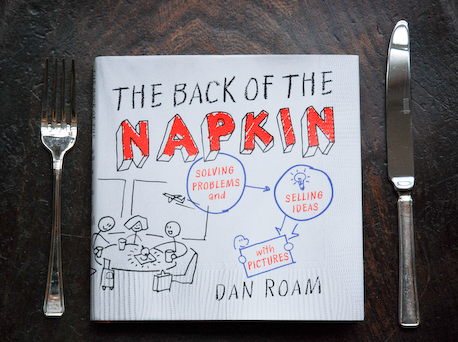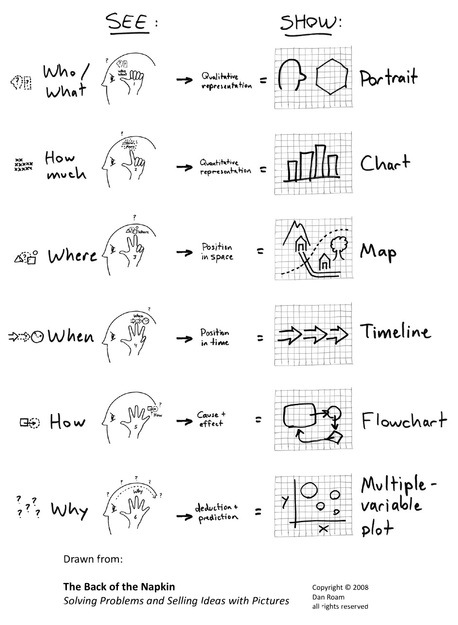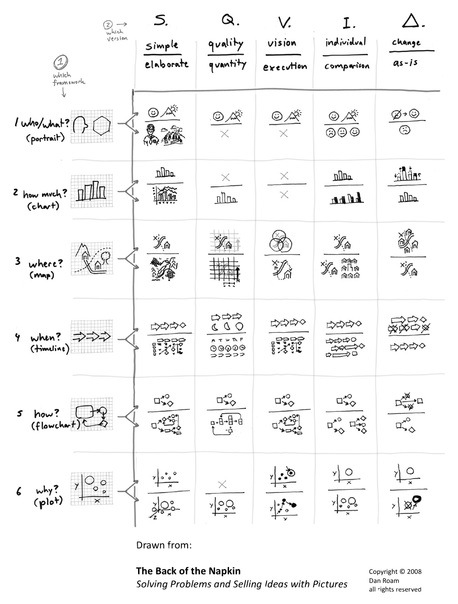The Back of The Napkin
The subtitle of Dan Roam’s best-selling book, The Back of the Napkin
The Back of the Napkin is squarely aimed at the business community, but it useful to a much wider audience. Books about those two battered and beaten terms, creativity and innovation, sell like hot cakes to a corporate world trying to claw its way out of decades of doing neither (listen up, U.S. auto industry). There is a lot of dross out there on the subject, but Roam manages to avoid these pitfalls by side-stepping any notions of God-give creative genius and delivering a set of hands-on visual thinking tools that are useful to everyone, trained designers included.
The premise of the book is that a simple diagram (on the back of a napkin) can explain complex ideas and that everyone is able to both think and understand visually because it is what we do all the time as we navigate our way through the world. A large part of the earlier chapters is about convincing those who say they have no visual thinking skills or that they “can’t draw” that they can and should try to do so. As a trained designer, you might be tempted to skip this thinking you know it all already, but there is interesting material in there and it sets up the rest of his approach very well.
Roam’s explanation for most people’s lack of visual thinking skills resonated with with some of the worst tendencies in software-driven design:
It’s as if we’ve been given a high-end desktop supercomputer as a gift, but we don’t know where to find any new software. Even though sight is for most of us the most highly developed of all our senses, when it comes to visual thinking, we limit ourselves to what is available right out of the box.
Remember that the next time you’re tempted by the lens flare filter in Photoshop.
(Click to enlarge)
Roam then explains four tools for visual thinking that are developed and integrated throughout the book by way of case studies. The first is that visual thinking is about seeing with our eyes, our mind’s eye and using our hands and eyes. This then leads to a process of looking, seeing, imagining and showing. In other words, we take in information, extend, develop and modify it in our imaginations and then have to work out a way to show that to others visually so that they can imagine it too.
So far, so good and pretty obvious to most designers. The two tools that Roam uses to develop this process may also be familiar, depending on the design discipline in which you work. One is called the <6><6> Rule and follows the classic set of questions: _Who/What? How much? Where? When? How? Why? _ These “seeing” questions lend themselves to certain kinds of “showing” diagrams. Where? would be best shown with a map, whereas How? would use a flow-chart, for example. Unsurprisingly, this starts to become easier to show in an image:
(Click to enlarge)
Roam then introduces the S.Q.V.I.D. tool whose initials stand for Simple, Quality, Vision, Individual, Change (the D is the triangle symbol from the greek Delta, which means change). Each of these has a visual opposite – Individual versus Comparison, Vision versus Execution, etc.
(Click to enlarge)
The trick is working out which type of diagrammatic approach is suited to working through and/or presenting the solution to a problem. This is something I suspect Roam has developed an intuitive knack for over the years, but fortunately he has developed the Visual Thinking Codex to help the rest of us navigate through the many combinations (and all of these are available as cheat-sheet PDFs from the book’s web site).
(Click to enlarge)
By the end of all this, you have a solid process with which to visually work through problem finding, solving and explaining.
As someone who is always skeptical about popular business books on creativity and business I have to admit to being thoroughly won over by the simplicity of Roam’s approach. The irony of the book is that it seems somewhat complicated when explained in written words. I imagine Roam could explain the whole thing in less that 30 minutes with a pen and paper in person.
Some designers might feel like they know all this already, but as a practitioner and teacher of interaction design I felt there was still a great deal to be learned from The Back of the Napkin. It inspired me to re-think many of my teaching approaches and ditch a few of the Keynote presentations (you didn’t think I would be using Powerpoint did you?).
(Click to enlarge)
Interaction, user experience, information architects and service designers will probably be the ones to find the tools and techniques of most use, but product designers will get a lot out of this too. Given that it is written for the business community and for solving problems and conveying ideas in general, it is obviously going to be of use in planning everything from your next career move to your company structure. If you are involved in strategy or software development or the more business side of the design business you will also find a lot of insights here.
What is great about the approach of The Back of the Napkin is that it means everyone working on a project ends up speaking the same language – a visual one. Roam’s easy writing style and clear diagrams make this an easily digestible addition to your creative diet and it lives up to the accolades it has received.
Buy The Back of the Napkin from Amazon.com









